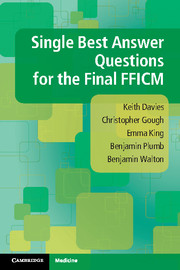Book contents
- Single Best Answer Questions for the Final FFICM
- Single Best Answer Questions for the Final FFICM
- Copyright page
- Contents
- Preface
- Exam A: Questions
- Exam A: Answers
- Exam B: Questions
- Exam B: Answers
- Exam C: Questions
- Exam C: Answers
- Exam D: Questions
- Exam D: Answers
- Exam E: Questions
- Exam E: Answers
- Exam F: Questions
- Exam F: Answers
- Exam G: Questions
- Exam G: Answers
- Exam H: Questions
- Exam H: Answers
- Index
- References
Exam C: - Answers
Published online by Cambridge University Press: 21 January 2017
- Single Best Answer Questions for the Final FFICM
- Single Best Answer Questions for the Final FFICM
- Copyright page
- Contents
- Preface
- Exam A: Questions
- Exam A: Answers
- Exam B: Questions
- Exam B: Answers
- Exam C: Questions
- Exam C: Answers
- Exam D: Questions
- Exam D: Answers
- Exam E: Questions
- Exam E: Answers
- Exam F: Questions
- Exam F: Answers
- Exam G: Questions
- Exam G: Answers
- Exam H: Questions
- Exam H: Answers
- Index
- References
Summary
On finding a collapsed 6-year-old child outside of the hospital setting and calling for help, what is the next thing to do?
- Type
- Chapter
- Information
- Single Best Answer Questions for the Final FFICM , pp. 98 - 133Publisher: Cambridge University PressPrint publication year: 2016

